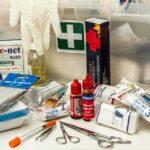As we think about breakouts from acne, most of us envision blemishes appearing on our face. However, acne can occur anywhere on your body including on your back – in fact it is so prevalent it has its own name: “bacne”. While facial acne may be painful and hard to manage, back acne is just as disfiguring and often makes people self-conscious especially if wearing spaghetti-strap dresses or fitness clothing which reveals your back or shoulders. Drcure.com understands how vital health care can be to our lives, but sometimes navigating it can be daunting. With this in mind, they strive to create an easy-to-use platform so that users can quickly locate information they require – whether its How to get rid of Acne guidance from us, treatment options research or advice on leading an active lifestyle we have you covered!
Leading Causes of Back Acne
Back acne has various causes, from hormones and genetics to lifestyle elements and environmental triggers. Determining which factor caused it can be challenging; back acne could be caused by whiteheads and blackheads as well as cysts forming on your upper back skin like those found on facial skin. Sebaceous glands release sebum (an oily substance).
Sebum helps lubricate and protect the skin, but too much sebum makes your follicles more vulnerable to becoming clogged with dead skin cells and excess oil, leading to back pores becoming blocked with ease due to thick skin in this region.
Common causes that contribute to back acne include:
- Hormones
- Genetics
- Sweat
- Hair products and sunscreens
- Foods you eat
- Nutritional deficiencies
Knowing what’s causing your back acne will enable you to identify the best solutions to both manage it and avoid future outbreaks. Making small adjustments in your life can significantly impact how acne manifests itself and potentially help prevent future breakouts – these 7 strategies will help manage it without returning again!
Avoid tight-fitting clothes, purse straps
Straps for purses, tight clothing or backpacks could be rubbing against your skin and contributing to back acne outbreaks. If this is happening to you currently, or is likely to in the future, try wearing clothes without irritating materials and switching out carrying bags for something looser until your back heals completely. Or you could try looser clothing options when sweaty conditions make life tougher – particularly during the heat of summer when sweaty conditions increase significantly.
Wash your workout clothes after every use
When sweating profusely throughout the day or during exercise, it’s best to wash off and change clothes immediately. Letting sweat remain on your skin after physical exertion increases the chances of breakouts; its oils can clog your pores causing obstructions. If showering is unavailable after exercising, an oil-free cleansing wipe is also an effective solution in areas that tend to produce breakouts, like neck, face and back.
Your workout clothing must be cleaned after every workout session to stay clean and in top condition for future workouts.
As a frequent exerciser, it may be tempting to skip washing your athletic bra and workout shirt even though they do not smell. But, to reduce the chances of developing back acne and keep yourself feeling your best while working out, try selecting moisture wicking clothing composed of cotton that allows airflow while simultaneously lessening friction.
Clean your skin gently
It may be tempting to scrub your back aggressively since its skin is thicker. Unfortunately, doing this could irritate it further and increase breakout risk. When dealing with acne-prone backs it’s especially important not to rub as this will aggravate symptoms further and can make healing more challenging.
If you are suffering from back acne, try using gentle acne cleanser products. According to the American Academy of Dermatology Association’s recommendations, allow the cleanser to sit on your body for approximately two minutes in order to better treat thick skin on your back. Be sure to read and follow all directions of each cleanser product used on you too.
Use non-comedogenic hair and skin products
To prevent your hair conditioner and sunscreen from causing breakouts, look for products marked non-comedogenic that do not contain ingredients known to clog pores and also ensure you thoroughly wash your hair after applying conditioners.
Watch what you eat
If you are struggling with acne breakouts, examining what you eat might be one potential source. According to studies, those with acne-prone skin could benefit from switching their diet up by opting for foods low in glucose which don’t spike their blood sugars quickly and can cause inflammation as well as boost sebum production as fast. Also be mindful that certain items could lead to acne outbreaks in certain people.
Even though back acne can be bothersome, you can manage and prevent further outbreaks if you know its source. Once you understand what may be triggering it, the more effectively you’ll be able to tackle the problem and stop future outbreaks.






